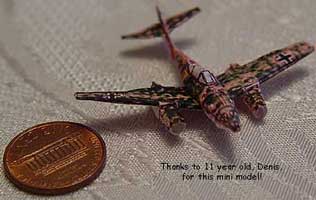
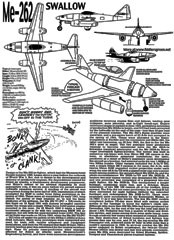
Messerschmitt-Me262 - $$7.50
Sleek and deadly..The Messerschmitt Me 262. During WWII's final two years this gas turbine-powered M2-262 was the great white hope of the Luftwaffe's Fighter Force. Far faster than any allied fighter type, with its powerful armament, it promised to be a potent bomber destroyer. Yet in combat, the revolutionary jet made little impact in any role. 1/12-15 1/20-16
Messerschmitt Me 262 "Swallow" WWII Jet Fighter
Please BOOKMARK this page as you leave
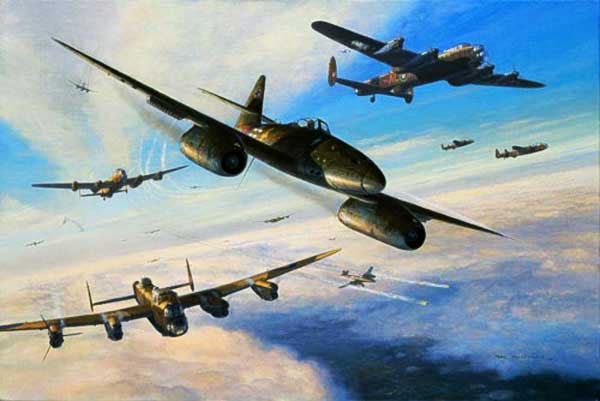
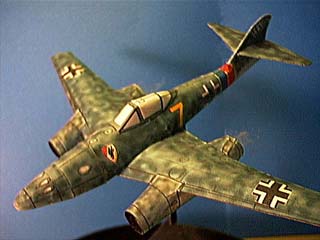
After having filled a waste paper basket with partially built models, I just finished 2 Fiddler's Green, ME262's that are now part of my collection. One is WSAM scale and the other is an HO scale model.They are both really fantastic. The way the engines build up is really ingenious. I found that the trick to building this model, is to make the center section of the model, which has tabs on both ends, oversize. In HO scale, I made the fuselage section about 1/16 of an inch oversize and on the 1/60 scale model, it is about 1/8 inch oversize. The HO scale model is so cool, that I immediately started work on a Texan in the same scale. How cool is it? Its so cute that my 13 year old daughter offered to take it and make it the first model in her own paper plane collection. Roger Cousineau, 3/14/01
Yes I was very skeptical of the method , especially as at the moment I use paper and not card for my models but it works. Probably a good idea to print out a few noses i.e. Me262 or Me163 and try them to get the hang of it. I am sure someone with more skill/experience than me will add/correct this for you. Forming noses are a pain, The last model I designed had a big one and I had to make it again and again and again. I hated it.But I found a trick that made it easy and I got pretty good at it. First I had been doing it by forming them around a ball of tissue paper with some glue on it, very messy but it works if you are careful. I was sitting at my desk and on it was a track-ball mouse. This is one of those logitech track balls with the control ball sitting in a cup shaped holder on top of the mouse. I removed the ball and looked in the hole. it was a spherical shaped depression in the top of the mouse. It occurred to me the hole was also just a little bigger diameter then the cruise missile nose. I cut out a cruise missile nose and formed it into a ring and let that dry. I put some glue on the insides of the petals. Then I took the ring, petals downward and pushed it into the hole on the mouse. The curved sides of the hole formed the petals together smoothly. I was able to hold the ring in the hole (all petals formed together with just two fingers.) Then with the other hand I took a small swatch of tissue and pressed it over the back of the petals and held it for a few seconds while the glue set into the tissue. I pulled the nose back out and viola a perfect nose. Since then I have been looking for items with similar shaped depressions (spherical) but with different diameters. I found a couple that will work (shot glasses) I will just keep collecting an assortment of shapes and keep them in a box till needed. Matthew Sparks
|
P.S. Jeremy said to mention that " the LAD in this case is 17y/o and 6' 4" -- "he sure makes nice planes though"...says his DAD |
Me-262 Messerschmitt (Swallow)
FIRST FLIGHT 1941
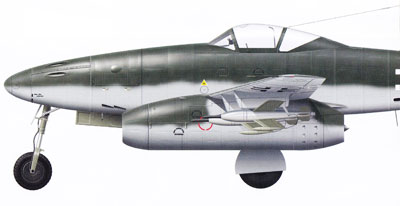 EXPECTATIONS that the axial-flow BMW114003 turbojet would reach
a workable stage by the end of 1939 resulted in Messerschmitt
being asked to design an aircraft to use it. By August 1940
work had begun on three prototypes. The Me262, as the design
was designated, was developed as a prospective fighter, and
featured slightly swept wings and a triangular-section fuselage,
the original tail wheel landing gear being changed subsequently
to a tricycle type in order to overcome difficulties in taking
off.
EXPECTATIONS that the axial-flow BMW114003 turbojet would reach
a workable stage by the end of 1939 resulted in Messerschmitt
being asked to design an aircraft to use it. By August 1940
work had begun on three prototypes. The Me262, as the design
was designated, was developed as a prospective fighter, and
featured slightly swept wings and a triangular-section fuselage,
the original tail wheel landing gear being changed subsequently
to a tricycle type in order to overcome difficulties in taking
off.
These were caused by the elevators failing to work effectively in the aerodynamic shadow of the deep fuselage. It was November 1941, however, before the first supposedly airworthy BMW 003s were ready for installation. By this time the Mc 262 VI first prototype had undergone flight trials with a nose-mounted piston engine, and fortunately this was retained for the first flight with the turbojets installed, in March 1942. Both jets suffered broken compressor blades within seconds of take-off, and the aircraft just managed to fly a circuit on its propeller.
It was to be nearly two more years before a redesigned BMW engine was completed, and in the meantime a pair of 1874-lb thrust Jumo 004A engines were fitted to the third prototype, the Me 262 V3 making a successful take-off and first flight with these engines in July 1942.
It was the end of 1943, however, before any of the prototypes was fitted with armament, and by then there was an additional requirement - from Hitler personally - for the type to carry bombs. But the Me 262 was now a top-priority program and in July 1944, the first production Me 262s were delivered to a special Luftwaffe test unit.
The first production model was the Me 262A-1a Schwalbe interceptor, with a nose armament of four 30-mm (1.18-in) MK 108 cannon. The poor performance of these weapons led to a number of alternative armament schemes being tested, including the use of cannon up to 55-mm (2.17-in) calibre. The use of wire-guided X-4 missiles was also proposed, but under wing racks for 12 spin stabilized R4M rockets on each side, introduced on the A-lb proved the most immediately effective solution.
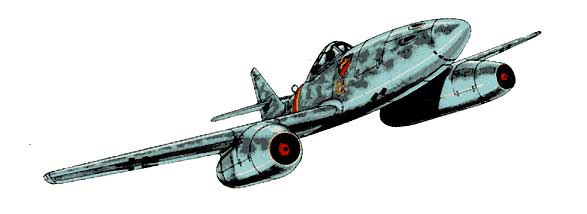
Other production variants in the A series included small numbers of the A-2a Sturmvogel fighter-bomber, which carried two 551-lb or one 1,102-lb bombs, one example being modified to accommodate a bomb-aimer in the nose, and the photo-reconnaissance A-5a, with only two MK 108s.
By the end of 1944 the Me 262B-la two-seat trainer had appeared, but only 15 were completed as such, a few more being given Neptune V radar to become B-1a/III night-fighters, and only one example of the definitive B-2a night-fighter, which was to have had Berlin radar, was flown during the war. Also, shortly before Germany's capitulation, two A-1's were fitted with rocket boosters to become the fast-climbing C-la and C-2a.
Shortages of time and resources prevented the Me 262s achieving service in sufficient numbers to have a significant effect on the course of the war. After 1945 some Me 262s were rebuilt in Czechoslovakia and entered Czech air force service as S-92s.
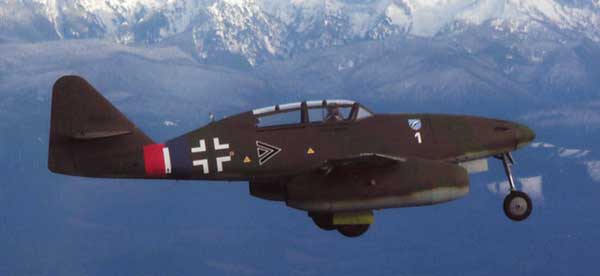
Design of the Me 262 jet fighter, which had the Messerschmitt Projekt number 1065, began about a year before the outbreak of World War II . But, due to delays in the development and delivery of satisfactory engines, the depredations caused by Allied air attacks, a troublesome development program, and Hitler's refusal to be advised regarding its most appropriate role, it was six years before the aircraft entered Luftwaffe squadron service.
A mockup of the aircraft was completed during the latter half of 1939, examination of which prompted the RLM to order three flying prototypes in the spring of 1940. These were all completed by early 1941, long before the arrival of their engines; so, to test the basic attributes of the airframe, the Me 262 VI (PC + UA) made its first flight on 18 April 1941 with dummy jet-engine nacelles under the wings and a single 700hp Jumo 21 OG piston engine mounted In the nose. On 25 March 1942 it made a barely successful attempt to fly with two under wing BMW 003 jet engines, but still with the nose-mounted Jumo 210G. The first all-jet flight was made on July 18, 1942, when the Me 262 V3 (PC + TIC) took off under the power of two 1,8521b st Jumo 004A turbojets. Many more prototypes were completed and used for trials with various armament and equipment installations, and from the VS onward (first flight 26 June 1943) a tricycle landing gear was substituted for the original tail wheel type.
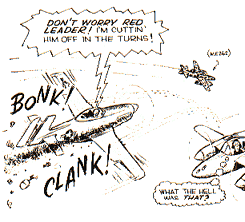
Plans for priority mass-production were seriously affected by Allied air attacks upon Messerschmitt's Regensburg factory, and there were numerous development problems involving engine fires and failures, landing gear collapses, guns jamming, and in-flight break-ups. Engine deliveries began in earnest in June 1944, permitting deliveries of production Me 262As to begin, and 513 had been accepted by the Luftwaffe by the end of the year-less than 40 per cent of the planned number. The Me 262's flying qualities were excellent, and a pre-series batch of 23 A-Os was accepted in the spring of 1944.
These were allocated to the Erprobungsstelle at Rechlin and the conversion unit EKdo 262, the latter unit becoming, on July 25, 1944, the first to fire the Me 262's guns in anger. The two principal basic production versions to become operational were the Me 262A-la Schwalbe (swallow) interceptor and the Me 262A-2a SturmVogel (stormbird) fighter-bomber. The former was built in numerous sub-types with four 30mm MX 108 cannon in the nose, or alternative armament installations; the latter, produced as a result of Hitler's insistence upon developing the aircraft as a bomber, had external racks for one 1,000kg or two 500kg bombs.
Other variants included the A-la/V 083, with a single 50mm BK
5 cannon in the nose; the A-lb, with twelve 55mm R4M unguided
rocket projectiles under each wing: the one-off A-2a/V2 with a
gla2ed nose-cap over a prone bomb-aiming position; the ground
attack Me 262A-3a; and the photo-reconnaissance Me 262A-la/V3
and Me 262A-Sa. A tandem two-seat trainer version was designated
Me 262B-la, and one prototype was completed of a proposed two-seat
night fighter, the Me 262B-2a. This incorporated a longer fuselage,
containing more fuel, and a SchrAge Musik installation of two
MK 108 cannon aft of the cockpit, firing upward. 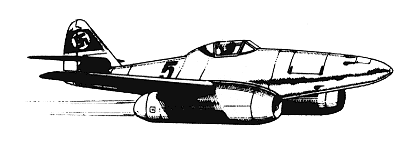
The B-2a did not enter production, but several B-las were convened for night fighting (without the extended fuselage) and redesignated Me 262B-1a/V1. These were employed quite successfully by the Kommando Welter, or 10./NIG II as it was later known. The few Me 262C models completed before VE-day were fitted with various rocket motors in the fuselage to boost the fighter's climb rate. Although little more than 500 Me 262s had been produced by December 1944, by the end of the war the total had risen to about 1,430.
Probably less than a quarter of these saw frontline service, and losses among them were quite heavy, even though relatively few losses were realized in combat. Despite this, their destruction of Allied bombers and fighters was greater than one for one, and JV 44, the top-scoring Me 262 interceptor unit, achieved some 50 kills in little more than a month's operations in 1945. In air-to-air combat the Me 262 never engaged its British counterpart, the twin-jet Gloster Meteor (which was slower and less well armed); conversely, many Me 262s were destroyed by Allied Mustang, Spitfire, Tempest and Thunderbolt piston-engine fighters.
Messerschmitt Me 262
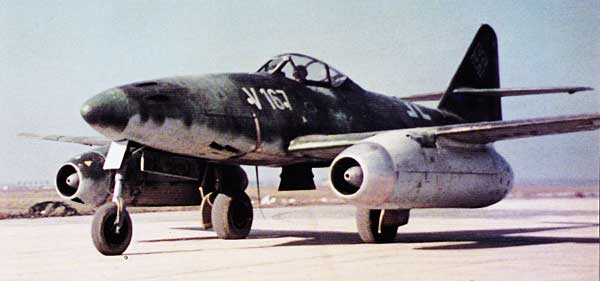
Young German gunners, huddled around their light 20-mm and 37-mm flak weapons, could be excused for a slight lack of attention to their task at their first sight of the Messerschmitt Me 262s on the snow-covered expanses of Rheine- Hopsten air base in 1944. In every sense the sleek, shark-like fuselage, mottled ochre and olive green and beset with razor wings from which hung the huge turbojets, was a portent of the future. The noise, the high-pitched whine and howl of the Jumo 0048-1 turbines, the swirls of snow, the hot paraffin-tainted blast: all were of a different time. This was the present, however, and, beset by Allied air superiority on all sides, the skies over-Westphalia were dangerous elements for operations of the Luftwaffe's dwindling strength. Black-helmeted pilots, crouched forward in the narrow cockpits of their Messerschmitt Me 262A-2a fighter-bombers, anxiously scanned the overcast skies for the first signs of the diving Hawker Tempests, North American P-51s or Supermarine Spitfires, as they coaxed throttles and jabbed brakes prior to take-off. Flak gunners trained their pieces along the approach paths, watched for the red Very lights that would bring them to instant action, and heard the thunder of the departing jets.
With such machines, how could Germany lose the war in the air? Such a thought must have raced through minds. The job of a flak gunner is humble, and he and his comrades could have had no insight into the extraordinary train of events and decisions that were instrumental in the denial in quantity of Germany's most potent air weapon of World-War II. In the heady days of 1941, when the Messerschmitt Me 262 series was born, not one person in the Third Reich could foresee the desperate need for an outstanding aircraft with which to wrest air supremacy from the hands of the enemy. The Heinkel concern was already deeply involved in the development of a fighter powered by the new reaction-turbine engines when, on January 4, 1939, the Augsburg-based Messerschmitt AG received orders from the German air ministry (RLM, or Reichsluftfahrtministerium) to produce specifications for a similar type of aircraft. Two plans were drawn up by a team led by Dipl Ing Waldemar Voigt, one for a twin-boom configuration and the other for a pod-and-boom design. Neither of the two then-existing turbojet designs was considered to be powerful enough for a single-engined fighter, and as a result Voigt was forced to resort to the design of a twin-engined aircraft.
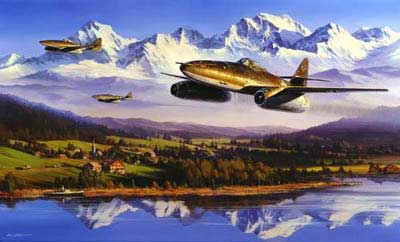 Early development:Germany's first definitive jet fighter
Early development:Germany's first definitive jet fighter
Heinkel had already turned to twin engines with the development
of the promising He 280 series powered by the six-stage axial-flow
BMW P 3302 engines, and , the
Heinkel He 280 V2 prototype, lifted off from Rostock-Marienehe's
runway at 15.18 on March 30, 1941 with Fritz Schafer at the controls.
(Within six weeks of this maiden flight, the UK, too, flew its first jet
aircraft: powered by a Whittle-designed W1X centrifugal-type turbo-
jet of 860-lb thrust, the Gloster E.28/39 took to the air on
May 15.) At Augsburg, work had proceeded slowly on the design of
what at first bore none of the hallmarks that graced the Heinkel product, or gave any hint of the fineness of line that was a characteristic of
Messerschmitt's piston-engined fighters. The design was termed the
Messerschmitt P 1065 V1 and, in the absence of its twin jet engines,
was fitted with a 730-hp Junkers Jumo 210G driving a two-
bladed propeller. This ugly duckling was then renamed the
Messerschmitt Me 262 V1, and was taken into the air for the first
time on April 18, 1941. Test pilots Karl Baur and Fritz Wendel reponed no vices on subsequent flight programs.
No urgency was attached lo the flight development of the Me 262 V1 during that summer, for little priority had been assigned. Of far greater import for the Messerschmitt concern were the improvements to the Bf 109 and Bf 110 combat types, and the development of their replacements. The engines for the Me 262 V1 eventually arrived from Spandau in mid-November 1941, being BMW 003s each of 1,213 lb static thrust. On his first flight with the BMW 003s, -Wendel suffered a double flame-out shortly after take-off and was forced to put PC+UA down with some damage.
Fortunately, an alternative to the touchy BMWs was available. This was the Junkers Jumo 004 which had been developed by Dr Anseim Franz's team since its award of a contract in July 1939 for a development specification. In their adherence to axial compressors, German engine designers showed much courage and foresight. This type of compressor was difficult to construct and balance, and was susceptible to vibration and could be damaged far more easily than the tough centrifugal type of compressor. It became apparent that the acceleration rates, fuel efficiency, power output, and drag coefficients of axial-flow turbojets far exceeded the figures produced by the tougher, and sometimes more reliable, centrifugal types. By August 1941, the Jumo 004 was giving 1,323 1b static thrust, and many of the earlier problems had been cured. Jumo 004s were installed on the Messerschmitt Me 262 V3 (PC+UC), and this aircraft, bereft of the piston engine and still with tailwheel landing gear, left Leipheim's runway on the morning of July 18,1942 in Wendel's experienced hands. lt looked correct in every way, and it flew beautifully, and henceforth the fortunes of the Messerschmitt Me 262 were to rise at the expense of its nearest rival, the Heinkel He 280, which suffered a series of setbacks until its eventual cancellation in March 1943.
In the Luftwaffe's interest
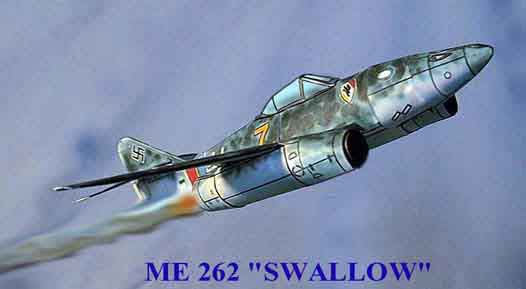
Service test pilots of the Erprobungsstelle (test establishment) at
Rechlin showed interest in the Me 262 from its earliest days. It was
largely at their instigation that Messerschmitt received contracts to
produce a number of prototypes for weapons and engine tests. The
experienced Major Wolfgang Spite had already reported his enthusiastic findings when the General der Jagdflieger, Adolf Galland, flew the
Me 262 V4 on May 22, 1943 and become unequivocal in his constant praise for this revolutionary aircraft At a conference in Berlin on
May 25, it was suggested that the piston-engined Messerschmitt
Me 209A be cancelled and that all efforts be directed to the production of the Me 262; a production order for 100 followed in three days.
Other events then took a hand. On August 17, 1943 the US 8th Air
Force's attack on Regensburg destroyed much of the embryonic
Me 262 production lines, forcing Messerschmitt AG to move its jet
development centers to Oberammergau, near the Bavarian Alps. The
delay occasioned by the move was increased by a chronic shortage in
the supply of skilled labor, and production slipped by many months.
In the meantime, the Me 262 V5 introduced the tricycle landing
gear that was to become standard, only on this prototype the nose
gear was fixed. The definitive Me 262 V6 (Jumo 004Bs) flew on October 17, 1943: VI+AA featured a retractable tricycle landing gear,
gun bays and blast ports, electrically operated tailplane, and a high-
speed wing with automatic leading-edge slats and trailing-edge flaps.
Can it carry bombs?
By the autumn of 1943, Germany was on the defensive in the
USSR and Italy, and was being subjected to furious aerial assault by
day and by night. Not least of Hitler's concerns was when and where
the Allies would strike in north-west Europe. During the amphibious
invasions in North Africa, Sicily, Salerno and Reggio, Allied air
power had kept the Luftwaffe and the German naval forces at bay,
and had thus prevented the loss of shipping that could have jeopardized the entire extent of these operations. Therefore, nobody could
have been surprised when many senior commanders, including Hitler,
mooted the concept of the Messerschmitt Me 262 as a fighter-bomber
as opposed to an interceptor, for the idea was tactically sound. It was
at Insterberg, in East Prussia, on November 26, 1943, that 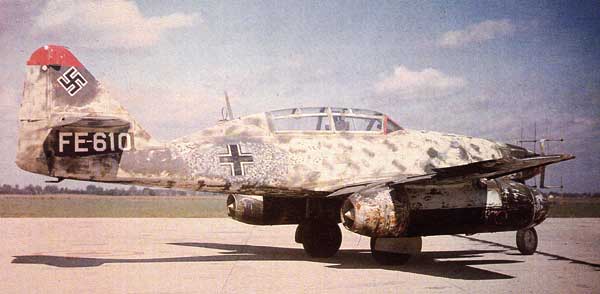 Hitler
watched the dove-grey VI+AA being put through its paces by Gerd
Linder. Present was Professor Willy Messerschmitt, to answer the
inevitable query from the fascinated Hitler: yes, indeed, the Me 262
could carry up to 2,205 lb of bombs with uncomplicated conversion work completed within two weeks per unit. So, from that
day the Messerschmitt Me 262 was destined to play a dual role, that of
fighter-bomber and that of a pure air-superiority fighter. Neither the
role nor the aircraft could by then have hid any influence on the outcome of the war. It was too late to start a major production scheme, as
oil and aviation kerosene, precious alloys, and skilled airframe and
engine specialists were all at a premium. The Messerschmitt Me 262
had been recognized in its full potential, but too late in the war.
Hitler
watched the dove-grey VI+AA being put through its paces by Gerd
Linder. Present was Professor Willy Messerschmitt, to answer the
inevitable query from the fascinated Hitler: yes, indeed, the Me 262
could carry up to 2,205 lb of bombs with uncomplicated conversion work completed within two weeks per unit. So, from that
day the Messerschmitt Me 262 was destined to play a dual role, that of
fighter-bomber and that of a pure air-superiority fighter. Neither the
role nor the aircraft could by then have hid any influence on the outcome of the war. It was too late to start a major production scheme, as
oil and aviation kerosene, precious alloys, and skilled airframe and
engine specialists were all at a premium. The Messerschmitt Me 262
had been recognized in its full potential, but too late in the war.
Service conversion of the Me 262 was placed under Hauptmann-Werner Thierfelder's Erprobungskommando 262 at Lechfeld, to where the unit moved on December 21, 1943. The EKdo 262 was given a batch of pre-production Me 262A-0 aircraft, and finally got into the swim of operation in the early summer of 1944. Thierfelder was killed in combat with 15th Air Force Mustangs over Bavaria on July 18, and his place was taken by Hauptmann Neumeyer.
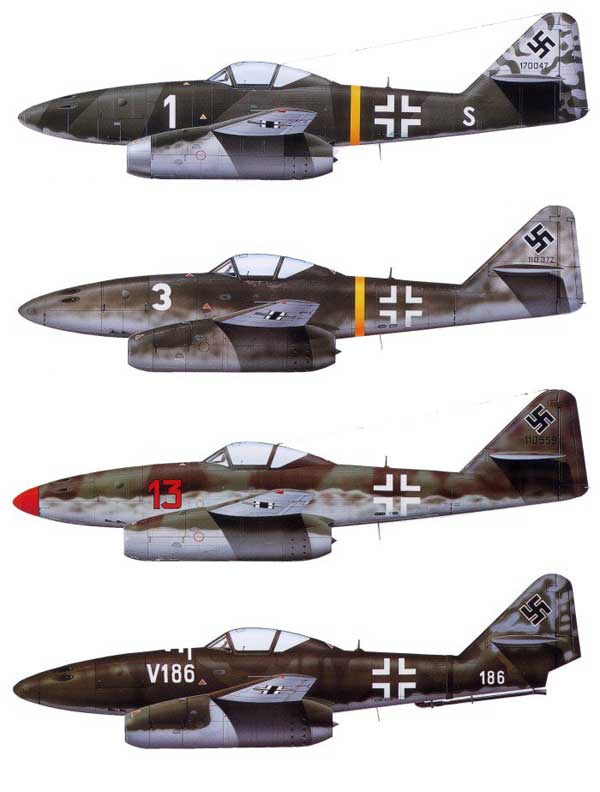 RAF discovers the Schwalbe
RAF discovers the Schwalbe
The RAF brought back its first confirmation of the Me 262's existence on July 25, when a de Havilland Mosquito of No. 544 (PR)
Squadron intercepted near Munich, Flight Lieutenant A. E. Wall
and his navigator Flying Officer A. S. Lobban escaping with difficulty.
Equipped with Messerschmitt Me 262A-2a fighter-bombers, the
Einsatzkommando Schenk (Major Wolfgang Schenk) was formed at
:Lechfeld in July, before posting to the Normandy invasion front. The
unit was based at Chateaudun, Etampes and Creil, before pulling back
to Juvincourt, near Reims, in late August. It was on August 28 1944
that Allied fighter pilots downed the first Me 262 to be lost in combat
near Brussels, Major Joseph Myers and his wingman, Lieutenant M.
D. Croy Jr. of the US 78th Fighter Group bounced Oberfeldwebel
Lauer's Me 262 to force it down in a field. Operations by
Einsatzkommando Schenk continued in a desultory manner until its
incorporation into I Gruppe of Kampfgeschwader 51, which began
combat operations from Rheine-Hopsten under Major Unrau in
October 1944. The value of the Me 262 as a reconnaissance aircraft was soon recognized, and a few went to the Einsatzkommando
Braunegg, and to Nahaufklarungsgruppen 1 and 6.
Hitler's firm insistence on Messerschmitt Me 262 being the property of the General der Kampfflieger (Marienfeld) denied Galland the opportunity of forming the first fighter unit until, September 1944. One of Germany's finest fighter pilots, Major Walter Nowotny, formed the Kommando Nowotny based at Achmer and Hesepe near Osnabruck, to fly its first mission against Allied bombers and fighters on October 3, 1944. The Messerschmitt Me 262A-1a (two Jumo 004B-1 turbojets) formed the establishment of around 30. The armament was exceptionally potent and consisted of four Rheinmetall-Borsig MK 108A-3 30-mm cannon; the pilot was protected by 9-mm back armor, and a 90-mm armour-glass windscreen. With a maximum speed of 531 mph 26,245 ft the Me 262A-1a could outrun anything that the Allies had in their inventory but proved to be vulnerable in the circuit pattern. Thus, several Me 262s succumbed to bold Allied fighter attacks during the approach and shortly after take-off. Initially, the Kommando Nowotny was given cover by III/JG 54 (Focke-Wulf Fw 190D-9s) from Varelbusch. But later some 120-140 Messerschmitt Bf 109G-10s and Bf 109K-4s and Focke-Wulfs were needed to protect I/KG 51's missions in the Rheine area, in addition to very strong flak defenses.
Kommando Nowotny disbanded shortly after the death of its leader on November 8, 1944. The potent jet, the presence of which thoroughly alarmed Allied intelligence in the west, continued to be used on bombing attacks on Allied front lines, reconnaissance missions, and an occasional foray against enemy fighters.
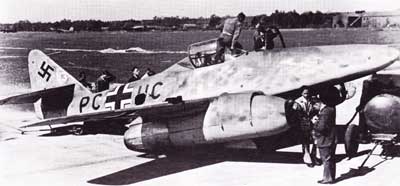 |
| The Me 262 V3 was the first prototype to fly on turbojet power alone, the date was July 18, 1942. |
Engine Problems |
||
In the late 1930s, engineers in Great Britain and Germany began for work on a new method of aircraft propulsion: the gas turbine engine. It promised far higher power-to-weight ratios than were possible with piston engines-without any reciprocating parts or airscrew conversion losses. There was a significant tradeoff at first. The gas turbine ran at far higher rotational speeds and far higher temperatures than its piston equivalents, and early examples were more difficult to control. Developing the new power unit was difficult enough, but German engineers faced a further problem. Owing to the Allied blockade; the hardening elements necessary for effective high-temperature-resistant steel alloys-in particular, chromium and nickel-were in short supply. Only limited quantities could be spared for the jet-engine program, so those who worked on the new propulsion system had to make the best of what was available. For the Jumo 004 engine that powered the Me 262, Junkers engineers used some substitute materials that were not up to the job. For example, the combustion chambers were made of mild steel and coated with baked-on aluminum to prevent them from oxidizing. When the engine was running, these combustion chambers slowly buckled out of shape. The turbine blades were made of a steel-based alloy that contained some nickel and chromium. That material was insufficiently resilient, however, when the engine was running, the centrifugal forces used the blades to elongate, or "creep."
Limited by combustion chamber buckling and turbine blade"creep,"
the running life of pre production Jumo 004s rarely reached
10 hours. Throughout a After much hard work to improve matters, late in June 1944, the Jumo 0048-4 emerged with a running life of 25 hours. That still wasn't impressive, and certain reliability problems remained, but the Luftwaffe couldn't afford to wait any longer. The design of the Jumo 0048-4 was "frozen" and the unit was put into mass production. During Sept '44, Jumo 004B-4 production reached significant levels, and that month, the Luftwaffe took delivery of 90 Me 262s.
|
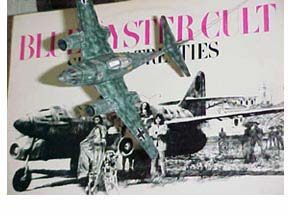 |
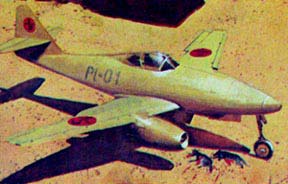 Picture thanks to the fine folk over at
Kozmik JellyFish Picture thanks to the fine folk over at
Kozmik JellyFish |
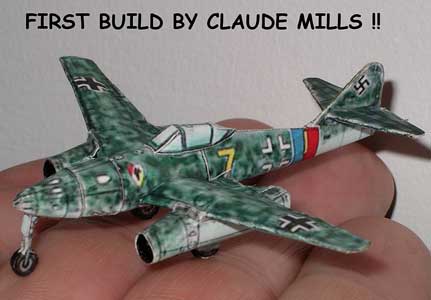
Several Fiddlers Green models have the orange-peel type of rounded nose shown above...To shape is not only easy, but lots of gooey, messy fun... A) After rolling the nose over a sharpened pencil , glue
together at the tab. |
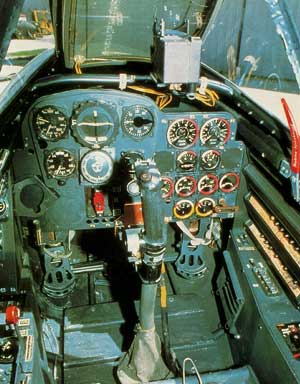 |
Messerschmitt Me 262 Swallow Cockpit. |
 |
The Jumo 004 turbo jet, the engine of the Messerschmitt Me 262 Swallow. |
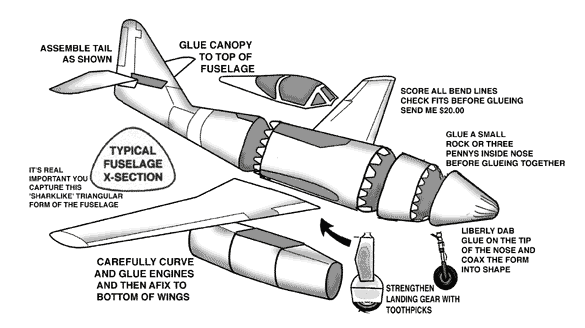
Specifications for the Messerschmitt ME 262 Swallow
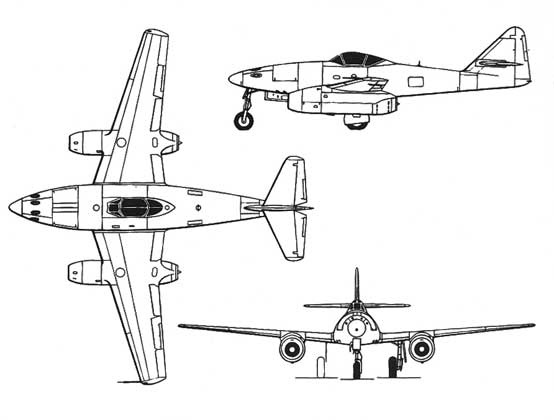 |
Length: 34 ft 9 in Wingspan: 41 ft 6 in Height: 11 ft 6 in Wing area: 234 ft² Empty weight: 9,709 lb Loaded weight: 15,720 lb Max takeoff weight: 15,381 lb Powerplant: 2× Junkers Jumo 004 B-1 turbojets, 1,980 lbf each Aspect ratio: 7.32 Performance Maximum speed: 559 mph Range: 652 mi Service ceiling: 37,565 ft Rate of climb: 3,900 ft/min Thrust/weight: 0.28 Armament Guns: 4 × 30 mm MK 108 cannons (A-2a: two cannons) Rockets: 24 × 55 mm (2.2 in) R4M rockets Bombs: 2 × 551 lb bombs or 2 × 1,102 lb bombs (A-2a only) |
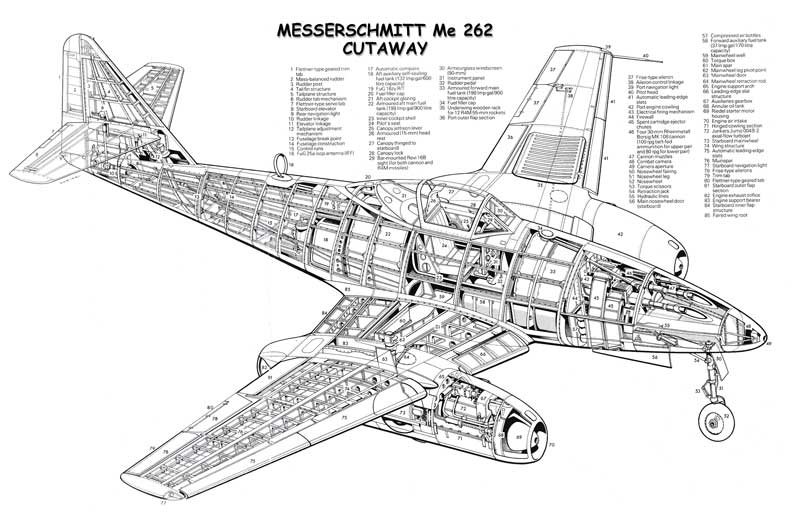 |
This 8.5x11 PDF cutaway of the Me 262 is included FREE when you purchase this model |



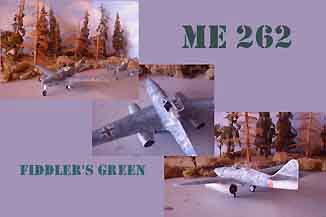 Jim
and son, Jeremy Cookson send in these great photos and
letter (see below). The feel of these scenes is that of
a Black Forest concealed air strip during the war. Notice
the clear canopy and wire antenna on the fuselage.
Jim
and son, Jeremy Cookson send in these great photos and
letter (see below). The feel of these scenes is that of
a Black Forest concealed air strip during the war. Notice
the clear canopy and wire antenna on the fuselage.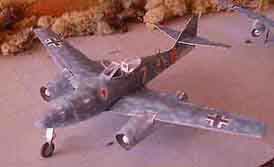 Dear Chip...
Dear Chip...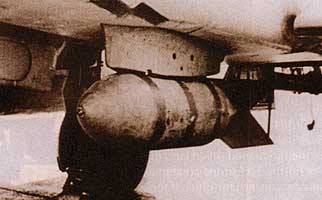
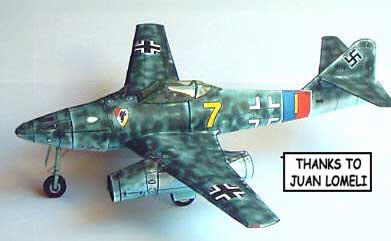 flight, careful throttle handling
was vital to avoid having an engine flame-out or overheat.
At altitudes of above 13,000 feet, the engine became increasingly
temperamental, and if it suffered a flameout, the pilot
had to descend below that altitude before he attempted a
relight. In its early form, the Jumo 004 had too many weaknesses
to allow mass-production.
flight, careful throttle handling
was vital to avoid having an engine flame-out or overheat.
At altitudes of above 13,000 feet, the engine became increasingly
temperamental, and if it suffered a flameout, the pilot
had to descend below that altitude before he attempted a
relight. In its early form, the Jumo 004 had too many weaknesses
to allow mass-production.